Are you a Quiet Speculation member?
If not, now is a perfect time to join up! Our powerful tools, breaking-news analysis, and exclusive Discord channel will make sure you stay up to date and ahead of the curve.
There's an odd lull in Magic right before the set release. There's no point discussing spoilers anymore; the set's known and being tested. However, those testing results are questionable. There hasn't been enough time to process the new cards and produce results, nor has the metagame adjusted to reflect these new cards. This means content tends to be more speculative. Today's article bucks that trend, instead focusing on some old, well-tested business that I've never gotten around to discussing: Modern Goblins.
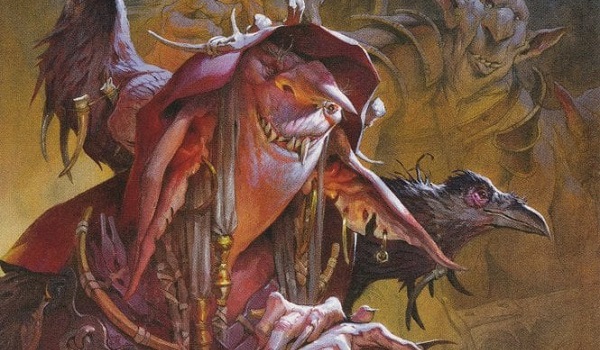
Over a year ago, I dug into Modern Goblins. Dominaria had just been released, and with it came Goblin Warchief and Skirk Prospector. It looked like a new era had dawned for the little red men. However, it wasn't meant to be. In my testing, whichever version of Goblins I tried proved anemic compared to alternative aggro decks. Goblins was very good at executing its gameplan, but it couldn't deal with disruption. It was mostly 1/1's and lacked card advantage, so any misstep spelled doom. I didn't see any future without Goblin Matron and Goblin Ringleader.
And then it happened. Modern Horizons brought not only Matron, but a replacement for Gempalm Incinerator in Munitions Expert. Then Core 2020 saw Ringleader reprinted. It looked like all the pieces now existed for a Goblins rebirth in Modern. Now, with months of testing under my belt, I can unveil my findings.
The Obvious Route: Pure Tribal
I started the same place I imagine everyone else did, with tribal Goblins. RB Goblin Bidding from Onslaught block is the deck most recent iterations aspire to, and with Goblins being one of Magic's original tribes, it just makes sense. The question is how to actually build the deck, and there's no single answer; it's extremely customizable. The core Goblins are Skirk Prospector, Mogg War Marshal, Goblin Matron, and Goblin Ringleader. Every other Goblin is negotiable depending on the metagame and what pilots wants from the deck. This does incentivize building a toolbox version, and my testing showed that it can be quite strong if the toolbox is built right.
That proved hard for me to consistently do, and given my existing bias towards aggro decks, I opted for a straight tribal aggro deck.
Tribal Goblins, Test Deck
I borrowed the Tarfire from Legacy Goblins, and I ended up tutoring for it so much I put in an extra. There's a surprising amount of tension in building the deck because so many of the best cards cost three or greater. I'm running Goblin Chieftain in this version, but Goblin Chainwhirler, Goblin King, Goblin Warchief, and Goblin Rabblemaster are all valid additions. Were I feeling more adventurous I might run a mix, but I prioritized reliability over raw power.
It's often said that Goblins isn't an aggro deck. The creatures are lackluster on their own, and curving Goblin Piledriver into Goblin Warchief isn't so impressive anymore. Therefore, it's better to take a controlling role, making Goblins a board-control beatdown deck. This is true of most versions, but it doesn't have to be. My version is 100% an aggro deck with the option to sideboard into something more controlling. The truth is that Goblins can be made to fulfil whichever role it needs to in the situation.
The Multicolored Question
One note is that when going the tribal route Goblins really should be red-black. Sling-Gang Lieutenant 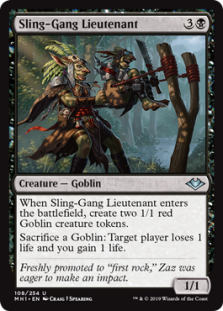 is an excellent finisher and sometimes the only route to victory. But Munitions Expert is the real all-star of the deck, and I recommend a full set. Modern being Modern, creature decks are everywhere, and Expert is instant-speed removal that synergizes with the deck. What pushes it over the top is the ability to kill planeswalkers. War of the Spark is casting a very long shadow, and not having to attack walkers away is extremely valuable. I had some good times in testing killing Karn, the Great Creator in response to Mycosynth Lattice, then attacking for lethal. Being RB also means that Gobins can run Thoughtseize if necessary.
is an excellent finisher and sometimes the only route to victory. But Munitions Expert is the real all-star of the deck, and I recommend a full set. Modern being Modern, creature decks are everywhere, and Expert is instant-speed removal that synergizes with the deck. What pushes it over the top is the ability to kill planeswalkers. War of the Spark is casting a very long shadow, and not having to attack walkers away is extremely valuable. I had some good times in testing killing Karn, the Great Creator in response to Mycosynth Lattice, then attacking for lethal. Being RB also means that Gobins can run Thoughtseize if necessary.
Control's Nightmare
As mentioned in my previous articles, Legacy Goblins is a nightmare for control decks, 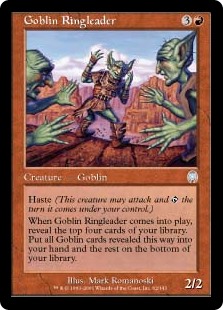 particularly straight UW. The traditional route to victory for control isn't to actually win the game, but to make opponents concede once all hope is lost. Between Matron, Ringleader, and token makers, it is almost impossible to adequately exhaust Goblins.
particularly straight UW. The traditional route to victory for control isn't to actually win the game, but to make opponents concede once all hope is lost. Between Matron, Ringleader, and token makers, it is almost impossible to adequately exhaust Goblins.
Cavern of Souls and Aether Vial moot a good chunk of control's best interaction. Stoneforge Mystic is trouble mostly because it's a 1/2 and thus blocks well, but the equipment isn't worrying thanks to the maindeckable Goblin Cratermaker and Goblin Trashmaster. Between Expert able to kill all control's win conditions and the sheer volume of cards Goblins can pull from, the matchup can be moved towards un-losable quite easily.
I found siding in Warren Weirding and Earwig Squad very effective for my deck, though it's not a strategy that works for every deck. Weirding's primary job is taking out the Baneslayer Angel's that control likes to bring in against creature decks, but in this deck it can also keep my board full when I'm throwing creatures away for damage. Squad exists to steal the few sweepers in UW, but can also take their win conditions in a pinch. This strategy works because I'm fully embracing being a go-wide aggro deck, and the slower toolbox builds can't throw away creatures as readily as I can.
Goblin's Nightmare
That said, I eventually abandoned tribal Goblins and started testing other decks. I had decent results, but never good enough to make me stay. A significant part of the problem is the metagame. The slower control decks that Goblins really beats on aren't an overwhelming metagame presence, and the overall picture hasn't been clear enough to metagame against. Goblins is a more like a creature-based control deck than a true beatdown deck, and that's a hard thing to make work in a shifting field.
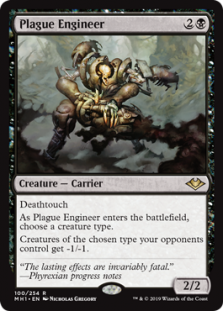 A far bigger problem for me was Jund. I could never find a reliable way to overcome the deck no matter how I tweaked Goblins, and the BGx stalwart is regaining popularity. Jund has always been solid against small creatures, but its fortunes improve further with access to Wrenn and Six. Worse, Plague Engineer is a card that kills almost everything in Goblins. The lords help some, but savvy Jund players prioritize removing those. In fact, Plague is such a house against Tribal Goblins that I found myself siding in more Tarfires, which are mediocre against Jund as a whole, and arguably a liability since they grow Tarmogoyf. However, I desperately needed reliable answers to Engineer, and Tarfire was better than anything else. Trying to sandbag around Engineer or go for critical-mass turns was also risky thanks to Jund's discard element.
A far bigger problem for me was Jund. I could never find a reliable way to overcome the deck no matter how I tweaked Goblins, and the BGx stalwart is regaining popularity. Jund has always been solid against small creatures, but its fortunes improve further with access to Wrenn and Six. Worse, Plague Engineer is a card that kills almost everything in Goblins. The lords help some, but savvy Jund players prioritize removing those. In fact, Plague is such a house against Tribal Goblins that I found myself siding in more Tarfires, which are mediocre against Jund as a whole, and arguably a liability since they grow Tarmogoyf. However, I desperately needed reliable answers to Engineer, and Tarfire was better than anything else. Trying to sandbag around Engineer or go for critical-mass turns was also risky thanks to Jund's discard element.
Thanks to the volatile metagame and the apparently unwinnable Jund matchup, I shelved the deck. There's a lot of potential, especially for experienced toolbox tuners, but the inherent weakness to Engineer made me look elsewhere.
Throw Away the Key
The next place I went was to a prison version, similar to Legacy Goblin Prison. The conceit is to use the prison elements to make up for the inherent weakness of the creatures; locking the opponent out of the game long enough for your medium beats to steal the game. In theory, the plan is very solid, and the deck works better than I initially gave it credit.
Prison Goblins, Test Deck
Being a Blood Moon deck I had to cut the black, and so had to make do with the pricier Siege-Gang Commander. Rather than lords, I took a page from Mono-Red Prison and ran a full set of Rabblemaster, which is a very good clock when protected by Chalice. I speculatively went with Trinisphere as my last maindeck prison piece. I had begun work on this deck before Faithless Looting was banned, and Sphere was incredible back then. It still has its moments, especially when accelerated into, but I'm thinking maindeck Ensnaring Bridge is better now.
Solid Locks...
 For my money, Blood Moon is highly underplayed. While it isn't very effective against Tron, there are vast swaths of the meta that behave like the card no longer exists. Jund, Humans, Death's Shadow, and Eldrazi decks are supremely vulnerable to the enchantment. Even decks with many basic lands like UW Control, Whirza, or Bant Blink heavily rely on their utility lands and fetchlands and can fail without them. In fact, I've found Blink decks to be so dependent on their fetchlands that they actually die to Moon.
For my money, Blood Moon is highly underplayed. While it isn't very effective against Tron, there are vast swaths of the meta that behave like the card no longer exists. Jund, Humans, Death's Shadow, and Eldrazi decks are supremely vulnerable to the enchantment. Even decks with many basic lands like UW Control, Whirza, or Bant Blink heavily rely on their utility lands and fetchlands and can fail without them. In fact, I've found Blink decks to be so dependent on their fetchlands that they actually die to Moon.
...Weak Doors
The problem is that Modern Prison isn't as potent as Legacy prison. Chalice for 1 invalidates the typical Delver deck, but almost every deck relies heavily on Brainstorm and Ponder to function. Modern decks aren't so restricted on mana cost, and thus are far harder to actually lock out of the game. This means that prison cards may be irritating, but they're not an end by themselves. There's a reason Whirza is moving towards straight combo and Lantern Control isn't a deck anymore.
Still an Improvement
That being said, I liked this deck better than the typical mono-Red Prison deck. Those decks have a lot more lock pieces and interaction, and can frequently get them out turns 1-2. However, they also have to. Without a relevant lock piece on the board, Mono-Red Prison becomes a fairly clunky Mono-Red Control deck, and there's a reason Skred Red is a fringe strategy. I stress relevant because sometimes they go all-in on the wrong piece, like Blood Moon against a mono-colored deck or Ensnaring Bridge against Tron. The decks have the capacity to completely lock out other decks, but if they fail to do so, they're massive underdogs.
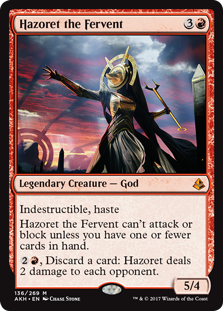 The other issue is the clock. Prison decks have some impressive threats like Hazoret the Fervent and Stormbreath Dragon, but there aren't many of them. It's not uncommon for the deck to use most of its opener pumping out a lock piece and then have to win with a single Chandra, Torch of Defiance and some lucky topdecks. If that one threat is answered, the opponent receives plenty of time to draw out of the prison. Modern isn't Legacy: Decks play more basic lands and a variety of mana costs.
The other issue is the clock. Prison decks have some impressive threats like Hazoret the Fervent and Stormbreath Dragon, but there aren't many of them. It's not uncommon for the deck to use most of its opener pumping out a lock piece and then have to win with a single Chandra, Torch of Defiance and some lucky topdecks. If that one threat is answered, the opponent receives plenty of time to draw out of the prison. Modern isn't Legacy: Decks play more basic lands and a variety of mana costs.
The Goblins version is not as good a prison deck and can't always lock opponents out quickly enough. It also doesn't have to. Goblin Prison isn't exceptional at any one thing, but it is above average as a combined prison-and-beatdown, or stompy, deck. It doesn't have to worry as much about drawing the wrong half of its deck as Red Prison, nor mulligan as aggressively as Colorless Eldrazi. Both of its competitors have better best hands, but Goblins has slightly better average hands, and that's preferable for me.
This transforms it into something surprisingly effective. The creature beatdown plan is perfectly serviceable on its own. When executed in conjunction with the prison pieces it tends to play like a decent tempo deck. The Goblins easily flood the board and close the game while the opponent is working around a Chalice or restricted by Moon. There is increased risk of whiffing with Ringleader and sometimes you draw too many prison pieces and just die, but I'd play Goblin Prison over Mono-Red Prison any day.
Just Kill 'em
The other option is the combo route. I abandoned anything like Dirty Kitty early in testing. It was fun to run an odd Storm deck and confuse my opponents to no end, but even with Matron and Ringleader, the deck was never consistent enough to be worthwhile. Modern combo decks need to be far leaner and more efficient than Fecundity decks can possibly be. Going for Abzan Company-style Murderous Redcap combos proved more fruitful. However, there was a lot of tension in splashing green for Collected Company and Rhythm of the Wild. In the end, I decided that staying RB and using Metallic Mimic was just as effective.
Combo Goblins, Test Deck
This deck may look like the tribal deck, but it's actually home to a number of different combos. I have Goblin Warchief primarily as a cost reducer to make comboing off easier since the pieces are fairly expensive. In addition to Redcap, a sacrifice outlet, and Metallic Mimic, there's Putrid Goblin to feed Sling-Gang Lieutenant. Pashalik Mons is an alternative kill condition for any loop and a decent value play by himself.
Easy, But Hard
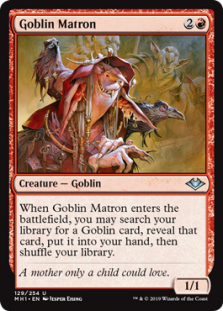 This was a very weird combo deck for me. It's almost alarmingly simple to find all the combo pieces, and often spares, thanks to Ringleader and Matron. Mimic is the sticking point, but Pashalik Mons alongside Lieutenant and Putrid Goblin frequently obviate the need for the full combo. Two damage triggers per sacrifice is very good, and given how often Goblins just floods the board, it has the same effect as the infinite combos. Multiple ways to achieve the combo combined with lots of ways to find the pieces meant that I could reliably get my pieces.
This was a very weird combo deck for me. It's almost alarmingly simple to find all the combo pieces, and often spares, thanks to Ringleader and Matron. Mimic is the sticking point, but Pashalik Mons alongside Lieutenant and Putrid Goblin frequently obviate the need for the full combo. Two damage triggers per sacrifice is very good, and given how often Goblins just floods the board, it has the same effect as the infinite combos. Multiple ways to achieve the combo combined with lots of ways to find the pieces meant that I could reliably get my pieces.
The problem was then getting them together on board. Without Vial, I was constantly choked on mana, and often Prospector couldn't make up the shortfall long enough to assemble the combo.
An Odd Hybrid
Ultimately, Combo Goblins didn't thrill me. It never felt necessary in light of Goblins' standard beatdown plan, which was still largely intact. In fact, it arguably hampered the beatdown strategy. I was tutoring to put the combo together rather than just killing my opponent by the shortest route possible, and while having something resistant to removal was sometimes nice, Putrid Goblin just didn't belong. I think Goblins is better off not trying for combo kills.
WAAAAAAAAGH
Were I to revisit Goblins in the future, I would definitely start with the combo version, but tune it in a beatdown direction. The Redcaps and combo aren't that impressive, but having the option to kill out of nowhere with Mons and Sling-Gang is too good to pass up. However, I'd need to see a large metagame shift to retake the plunge. Specifically, I'd need to see more control and non-Jund midrange than fast aggro or Whirza. Given how Modern is still catching up with everything that happened over the summer and a new set is coming out, Goblins will need to keep waiting.





Now we have a totally different reason to consider the green splash, grumgully the generous. Unlike mimic, he is a hit off of matron and ringleader, making the combo even easier to assemble